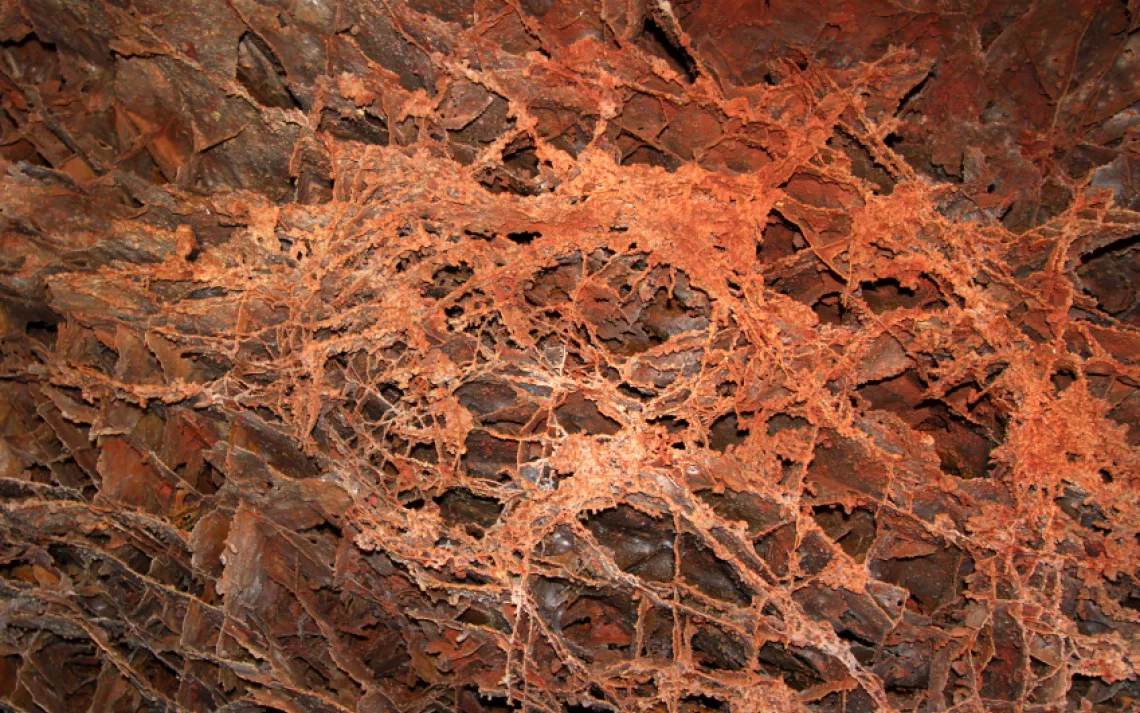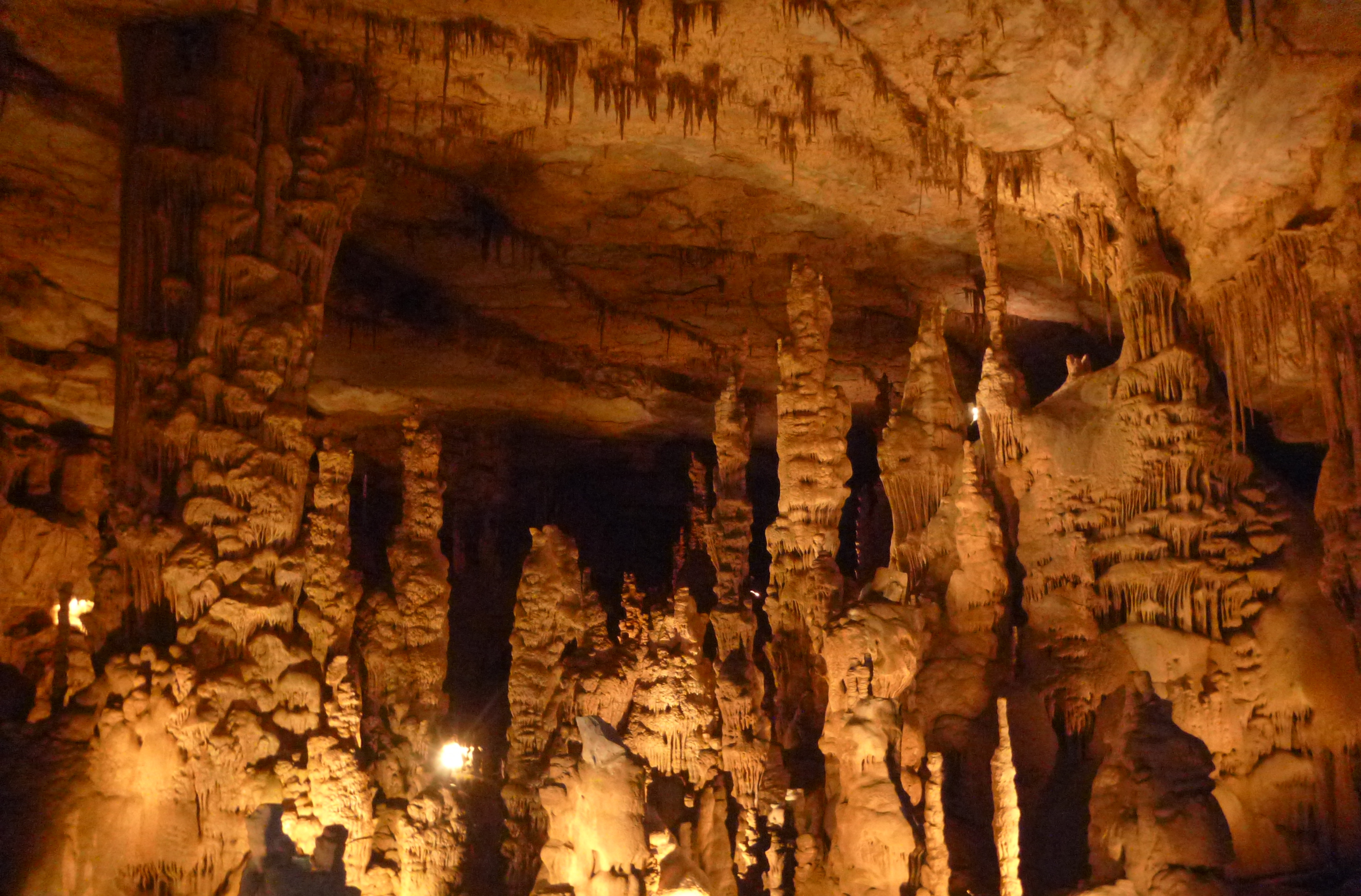Spelunkers Beware: These Are the 5 Spookiest Caves in America

These dark, underground labyrinths are full of mystery and adventure. Get ready for Halloween by exploring one of these five spooky caves.
CATHEDRAL CAVERNS (Alabama)
Alabama’s newest state park has enjoyed that designation for fewer than thirty years, but a visit to Cathedral Caverns in Marshall County exhibits eons of geological function in otherworldly relief. The cave’s mouth is more akin to a gaping maw, stretching over 120 feet across. The full extent of the cave is unknown, with only about two miles mapped and open to the public. That’s still enough room for visitors to witness ancient moments of frozen time. Electric lights cast an eerie orange glow on features like a 135-foot “waterfall” of flowstone, a stalactite forest, and “Goliath,” a stalagmite over 40 feet tall and 240 feet in circumference. Geological marvels aside, the cave has shown its dangerous side. The directors of the 1985 zombie flick What Waits Below filmed much of the principal photography in Cathedral Caverns. During shooting, 17 members of the cast and crew suffered carbon monoxide poisoning and had to be rushed to the hospital, narrowly avoiding a fatal dose. B-movie? Beware.

MOANING CAVERN (Califonia)
Part of what makes caves spooky is the ambient “breathing” sound of hot and cool air cycling through narrow openings. What if, however, you knew nothing about the vagaries of atmospheric pressure? That ominous respiration might caution you to steer clear, or curiosity might put you in serious peril. For the nearly 100 prehistoric people whose remains have been found at the bottom of Moaning Cavern in Calaveras County, CA, the titular moan served as more of a Siren’s Song. The circular whoosh of air tempted people to their death down the cave’s 410-foot chasm as far back as 13,000 years ago. Today, public tours extend as deep as 165 feet into the vertical opening. The brave and the bold can rappel down, but they’ll still have to exit up the gothic, wrought iron staircase. Don’t slip! It’s a long way down. While you’re there, ask about the cave’s mysterious disappearing chamber.
HELLHOLE (West Virginia)

Whoever named this cave did not mince words. This spot, in West Virginia’s Germany Valley, is locally notorious, enough to inspire a eponymous 2011 horror novel. Despite its title, Hellhole is more chilling than sweltering, but no less creepy for the discrepancy. Sporting an average temperature of 47 degrees Fahrenheit, Hellhole is a perfect hibernaculum for a variety of bats and rare cave-dwelling invertebrates. In fact, Hellhole is the winter home for about half of the world’s population of Virginia big-eared bats. Obviously, all creatures deserve respect and protection, double for this critically endangered and highly vulnerable species, but that does not stop a chill from going down our spines at the thought of a 20,000-strong cloud of squeaking, fluttering bats.
WIND CAVE (South Dakota)

OK, so maybe there’s nothing inherently scary about Wind Cave in South Dakota’s Wind Cave national park. There are no ancient remains, no roiling clusters of bats. Yet the cave is home to a rare geological feature that still makes us shiver. Nowhere else in the world will spelunkers find a more extensive network of “boxwork” calcite. Exactly how Wind Cave formulated the perfect conditions for boxwork remains a mystery. What’s clearer is that boxwork too closely resembles an enormous spider web for comfort. It’s just a geological anomaly, but still, it’s difficult to look at the boxwork and not imagine an army of petrified cave spiders skittering along the thin strands of hardened minerals. Boom, enjoy those heebie-jeebies.
BELL WITCH CAVE (Tennessee)
It’s easy to explain away the scary aspects of the other entries in this list. Not so for Bell Witch Cave. In Adams, Tennessee, this relatively small cave serves as the focal point for a legend equal parts terrifying and fantastic. As lore has it, in the early part of the 19th century, the farmer John Bell and his family suffered the handiwork of a poltergeist that apparently had a bone to pick. For several years, the “Bell Witch” (as it came to be known) raised ruckus at night, ripped sheets from beds, physically attacked John Bell and his daughter Betsy and supplemented it all with loud, boastful taunts. The witch became so renowned that even Andrew Jackson purportedly visited Adams as a curiosity seeker. John Bell’s torment finally ended in 1820, when he died under mysterious circumstances. Some accounts hold that a vial of unidentified black liquid was found near Bell’s body, and the witch claimed responsibility for poisoning him. Soon after, the disruptions tapered off and the witch retired to a cave near the old Bell farm, promising to return when the time was right. Locals still periodically report strange occurrences around the cave, and swear that removing anything will invite the Bell Witch into the pilferer’s life. No matter how skeptical you are about its haunted past, the supposed home of the Bell Witch is sure to make your skin crawl.
 The Magazine of The Sierra Club
The Magazine of The Sierra Club



